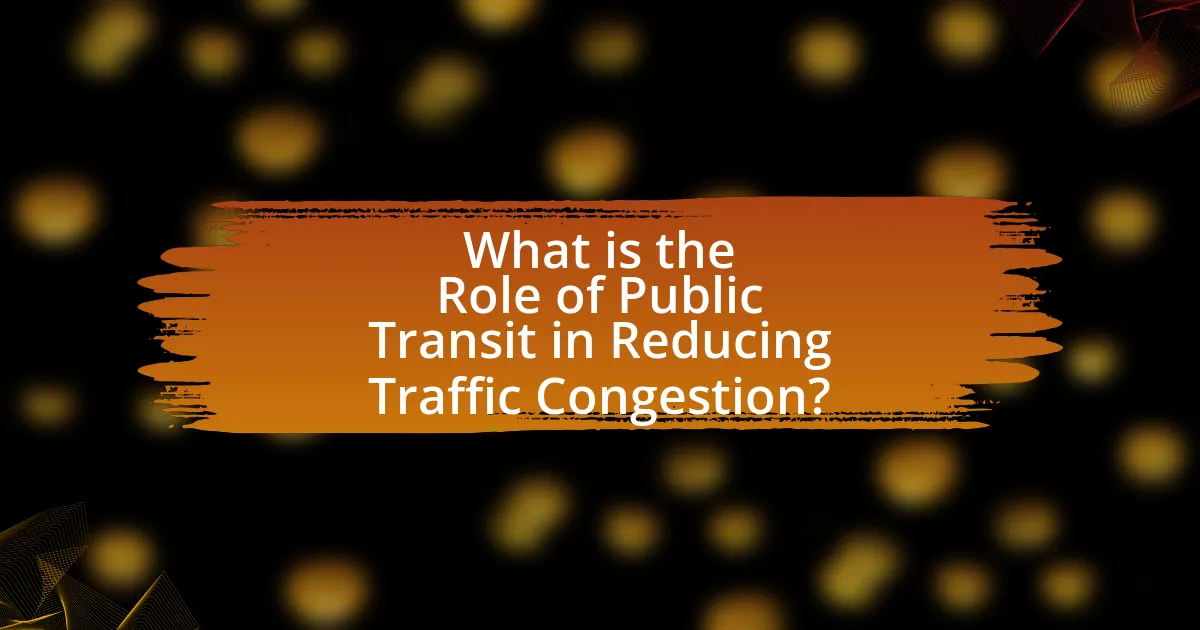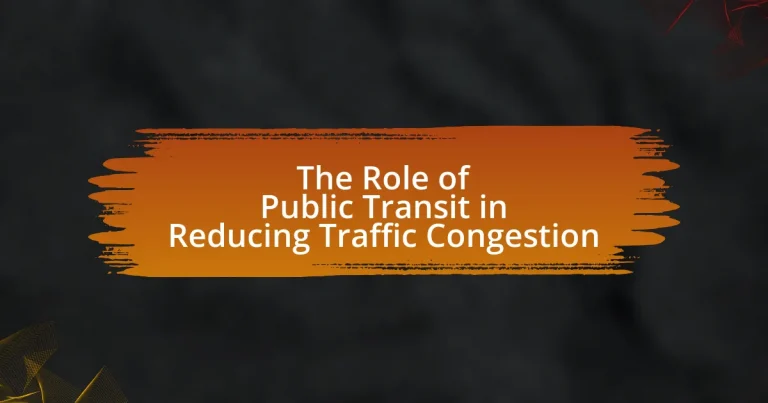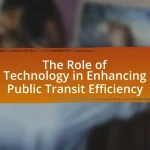Public transit is a vital component in mitigating traffic congestion by offering an efficient alternative to single-occupancy vehicles. The article examines how public transit reduces the number of cars on the road, leading to decreased gasoline consumption and lower carbon emissions. It highlights the mechanisms through which public transit influences commuter behavior, enhances urban mobility, and provides environmental benefits. Additionally, the article addresses the challenges faced by public transit systems, the importance of infrastructure and funding, and strategies for improving service and increasing ridership. Overall, it underscores the significance of public transit in creating sustainable urban environments and reducing traffic congestion.

What is the Role of Public Transit in Reducing Traffic Congestion?
Public transit plays a crucial role in reducing traffic congestion by providing an efficient alternative to single-occupancy vehicles. By increasing the number of passengers per vehicle, public transit systems can significantly decrease the number of cars on the road. For instance, a study by the American Public Transportation Association found that public transit use in the United States saves approximately 4.2 billion gallons of gasoline annually, which translates to a reduction of 37 million metric tons of carbon dioxide emissions. This reduction in vehicle numbers leads to less congestion, shorter travel times, and improved air quality in urban areas.
How does public transit contribute to alleviating traffic congestion?
Public transit alleviates traffic congestion by providing a more efficient means of transportation for large numbers of people, thereby reducing the number of individual vehicles on the road. For instance, a single bus can replace up to 50 cars, significantly decreasing road occupancy. Studies have shown that cities with robust public transit systems experience lower traffic congestion levels; for example, a report from the American Public Transportation Association indicates that public transit use saves approximately 4.2 billion gallons of gasoline annually, which translates to reduced traffic and emissions. Additionally, effective public transit networks encourage higher-density development, which further minimizes the need for personal vehicle use, leading to a more sustainable urban environment.
What are the key mechanisms through which public transit reduces traffic volume?
Public transit reduces traffic volume primarily by providing an efficient alternative to single-occupancy vehicles, thereby decreasing the number of cars on the road. By offering reliable and frequent service, public transit encourages commuters to opt for buses, trains, or subways instead of driving, which directly lowers vehicle counts. For instance, studies indicate that a 10% increase in public transit ridership can lead to a 1% reduction in traffic congestion. Additionally, public transit systems often promote higher density development around transit stations, which reduces the need for long-distance travel and further diminishes traffic volume.
How does public transit influence commuter behavior and choices?
Public transit significantly influences commuter behavior and choices by providing an alternative to personal vehicle use, thereby encouraging more sustainable travel patterns. Studies show that areas with robust public transit systems experience reduced traffic congestion, as commuters opt for buses, trains, or subways instead of driving. For instance, research from the American Public Transportation Association indicates that public transit use can reduce individual carbon footprints by up to 45% compared to driving alone. Additionally, the availability of reliable public transit options often leads to increased accessibility to jobs and services, which further shapes commuter decisions. This shift not only alleviates road congestion but also promotes a more efficient urban environment.
Why is public transit essential for urban mobility?
Public transit is essential for urban mobility because it provides an efficient means of transportation that reduces the number of private vehicles on the road. By facilitating the movement of large numbers of people simultaneously, public transit systems, such as buses and trains, help to alleviate traffic congestion, which is a significant issue in urban areas. According to the American Public Transportation Association, public transit saves the United States approximately 4.2 billion gallons of gasoline annually, demonstrating its impact on reducing reliance on personal vehicles and promoting sustainable urban transport solutions.
What are the environmental benefits of using public transit?
Public transit significantly reduces greenhouse gas emissions and air pollution. By transporting multiple passengers simultaneously, public transit systems, such as buses and trains, decrease the number of individual vehicles on the road, leading to lower overall emissions. For instance, the American Public Transportation Association reports that public transit saves approximately 45 million metric tons of carbon dioxide annually, equivalent to the emissions from 9.5 million cars. Additionally, public transit contributes to reduced traffic congestion, which further minimizes fuel consumption and emissions from idling vehicles.
How does public transit improve accessibility for different populations?
Public transit improves accessibility for different populations by providing affordable and reliable transportation options that connect individuals to essential services, employment opportunities, and social activities. For instance, studies show that public transit systems can reduce travel costs by up to 50% compared to private vehicle ownership, making it easier for low-income individuals to access jobs and education. Additionally, public transit often includes features such as wheelchair ramps and designated seating, which enhance mobility for people with disabilities. According to the American Public Transportation Association, public transit reduces traffic congestion by removing approximately 45 million cars from the road each year, thereby improving overall accessibility for all users.
What challenges does public transit face in reducing traffic congestion?
Public transit faces significant challenges in reducing traffic congestion, primarily due to limited coverage and frequency, inadequate infrastructure, and public perception issues. Limited coverage and frequency hinder accessibility, as many potential users may find public transit routes inconvenient or infrequent, leading to reliance on personal vehicles. Inadequate infrastructure, such as insufficient dedicated bus lanes or transit priority signals, results in slower travel times for public transit compared to cars, discouraging use. Additionally, public perception issues, including concerns about safety, cleanliness, and reliability, further deter individuals from choosing public transit over personal vehicles. These factors collectively impede the effectiveness of public transit in alleviating traffic congestion.
How do funding and investment impact public transit effectiveness?
Funding and investment significantly enhance public transit effectiveness by enabling the development and maintenance of infrastructure, improving service frequency, and expanding coverage. For instance, cities that allocate substantial financial resources to public transit systems, such as New York and San Francisco, often experience higher ridership rates and reduced traffic congestion. According to the American Public Transportation Association, every $1 invested in public transit generates approximately $4 in economic returns, demonstrating the direct correlation between funding levels and transit performance. Enhanced funding allows for the acquisition of modern vehicles, implementation of advanced technologies, and better overall service quality, which collectively contribute to increased public transit usage and decreased reliance on personal vehicles.
What role does infrastructure play in the success of public transit systems?
Infrastructure is crucial for the success of public transit systems as it directly impacts their efficiency, accessibility, and reliability. Well-designed infrastructure, such as dedicated bus lanes, rail systems, and transit hubs, facilitates faster and more reliable service, encouraging higher ridership. For instance, cities with extensive rail networks, like Tokyo, experience lower traffic congestion due to the high volume of commuters using public transit instead of personal vehicles. Additionally, studies show that investments in public transit infrastructure can lead to a 10-20% increase in ridership, demonstrating its significant role in enhancing the overall effectiveness of transit systems.
How can public transit systems be improved to further reduce traffic congestion?
Public transit systems can be improved to further reduce traffic congestion by enhancing service frequency, expanding coverage, and integrating multimodal transport options. Increasing service frequency encourages higher ridership by reducing wait times, as evidenced by studies showing that cities with more frequent transit services experience up to a 30% increase in ridership. Expanding coverage to underserved areas ensures that more people have access to public transit, which can lead to a decrease in personal vehicle use. Additionally, integrating multimodal transport options, such as bike-sharing and ride-hailing services, creates a seamless travel experience, making public transit more attractive. Research indicates that cities implementing such integrated systems see a significant reduction in traffic congestion, with some reporting decreases of up to 20% in peak-hour traffic.
What innovative technologies can enhance public transit efficiency?
Innovative technologies that can enhance public transit efficiency include real-time tracking systems, automated fare collection, and smart traffic management systems. Real-time tracking systems, such as GPS-enabled apps, allow passengers to receive live updates on transit schedules and vehicle locations, improving user experience and reducing wait times. Automated fare collection systems streamline the payment process, minimizing delays at boarding points and increasing overall throughput. Smart traffic management systems utilize data analytics and artificial intelligence to optimize traffic flow, prioritize public transit vehicles at intersections, and reduce congestion, thereby enhancing the efficiency of public transit networks. These technologies collectively contribute to a more reliable and efficient public transit system, ultimately aiding in the reduction of traffic congestion.
How can community engagement improve public transit usage?
Community engagement can improve public transit usage by fostering a sense of ownership and awareness among residents. When communities actively participate in the planning and decision-making processes regarding public transit, they are more likely to advocate for and utilize these services. Research indicates that cities with strong community involvement in transit planning see a 20% increase in ridership, as residents feel their needs and preferences are being addressed. Engaging the community through surveys, public meetings, and outreach programs ensures that transit services are tailored to local demands, ultimately leading to higher usage rates and reduced traffic congestion.
What are the best practices for promoting public transit as a solution to traffic congestion?
The best practices for promoting public transit as a solution to traffic congestion include enhancing service reliability, improving accessibility, and implementing effective marketing strategies. Enhancing service reliability involves increasing the frequency of transit services and ensuring punctuality, which can lead to higher ridership; for instance, cities that have adopted real-time tracking systems have seen a 20% increase in public transit usage. Improving accessibility means ensuring that transit stations are conveniently located and that services are available to underserved areas, which can significantly boost ridership among diverse populations. Effective marketing strategies, such as targeted campaigns that highlight the cost savings and environmental benefits of using public transit, can also encourage more people to choose transit over personal vehicles. These practices collectively contribute to reducing traffic congestion by providing a viable alternative to driving.
How can cities effectively market public transit options to residents?
Cities can effectively market public transit options to residents by utilizing targeted communication strategies that highlight convenience, cost savings, and environmental benefits. For instance, cities can implement social media campaigns and local advertisements that showcase real-time transit information, emphasizing reduced wait times and increased service frequency. Research indicates that cities with robust marketing efforts, such as San Francisco’s “GoSF” campaign, saw a 10% increase in public transit ridership over two years. Additionally, offering incentives like discounted fares for first-time users can attract new riders and demonstrate the financial advantages of public transit compared to driving.
What strategies can be implemented to increase ridership on public transit?
To increase ridership on public transit, implementing strategies such as improving service frequency, enhancing route coverage, and providing fare incentives is essential. Research indicates that increasing service frequency can lead to a 20% increase in ridership, as seen in cities like Los Angeles, where the Metro’s service improvements resulted in significant ridership growth. Additionally, expanding route coverage to underserved areas can attract new riders, as evidenced by studies showing that access to public transit increases by 30% when routes are extended. Offering fare incentives, such as discounts for students or low-income individuals, has been shown to boost ridership by making public transit more affordable, with programs in cities like San Francisco leading to a 15% increase in usage among targeted demographics.


